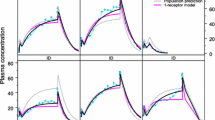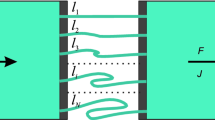Abstract
We develop a model to describe the time course of plasma concentration of neuromuscular blocking agents used as anesthetics during surgery. This model, which overcomes the limitations of the classical compartment models routinely used in pharmacokinetics, incorporates spatial effects due to heterogeneity in the circulation: it takes the form of a dispersion equation on a circular domain, with a time-dependent leakage term. This term is fitted to the functional form desired once first-stage transients have died out. Comparisons are made with clinical data by adjusting three parameters in the model.
Similar content being viewed by others
References
Avram, M. J., T. C. Krejcie and T. K. Henthorn (1990). The relationship of age to the pharmacokinetics of early drug distribution: the concurrent disposition of thiopental and indocyanine green. Anesthesiology 72, 403–411.
Avram, M. J., T. C. Krejcie, C. U. Niemann, C. Klein, W. B. Gentry, C. A. Shanks and T. K. Henthorn (1997). The effect of halotane on the recirculatory pharmacokinetics of physiologic markers. Anesthesiology 87, 1381–1393.
Bischoff, K. B. (1986). Physiological pharmacokinetics. Bull. Math. Biol. 48, 309–322.
Cassot, F., A. Saadjan and C. McKay (1978). Heat and mass transfer of a thermal indicator in a pulsatile flow through the cardio-pulmonary system. Med. Prog. Technol. 5, 203–214.
Chiou, W. L. (1979). Potential pitfalls in the conventional pharmacokinetic studies: effects of the initial mixing of drug in blood and the pulmonary first-pass elimination. J. Pharmacokinet. Biopharm. 7, 527–536.
DiStefano, J. J. III (1989). Hormone Kinetic Analysis, in Endocrinology, 2nd edn, Vol. 3, L. J. DeGroot (Ed.), Philadelphia: W. B. Saunders Company, pp. 2726–2740.
Donati, F., F. Varin, J. Ducharme, S. S. Gill, Y. Théorêt and D. R. Bevan (1991). Pharmacokinetics and pharmacodynamics of atracurium obtained with arterial and venous blood samples. Clin. Pharmacol. Ther. 49, 515–522.
Ducharme, J., F. Varin, D. R. Bevan and F. Donati (1993). Importance of early blood sampling on vecuronium pharmacokinetics and pharmacodynamic parameters. Clin. Pharmacokinet. 24, 507–518.
Goresky, C. A. (1984). The modeling of tracer exchange and sequestration in the liver. Federation Proc. 43, 154–160.
Goresky, C. A., G. G. Bach, A. W. Wolkoff, C. P. Rose and D. Cousineau (1985). Sequestered tracer outflow in multipleindicator dilution experiments. Hepatology 5, 805–814.
Henthorn, T. K., M. J. Avram, T. C. Krejcie, C. A. Shanks, A. Asada and D. A. Kaczynski (1992). Minimal compartmental model of circulatory mixing of indocyanine green. Am. J. Physiol. 262, H903–H910.
Jacquez, J. A. (1996). Compartmental Analysis in Biology and Medicine, 3rd edn, Ann Arbor: The University of Michigan.
Knapp, W. H., H. J. Lüdecke and J. Doll (1979). Calculation of residence time distributions of intravascular radioactive tracer in fields of external registration. Eur. J. Nucl. Med. 4, 471–477.
Krejcie, T. C., T. K. Henthorn, C. U. Niemann, C. Klein, D. K. Gupta, W. B. Gentry, C. A. Shanks and M. J. Avram (1996). Recirculatory pharmacokinetics models of markers of blood, extracellular fluid and total body water administered concomitantly. J. Pharmacol. Exp. Ther. 278, 1050–1057.
Leblanc, P. P., J. M. Aiache, J. G. Besner, P. Buri, M. Lesne and coll. (1997). Traité de Biopharmacie et Pharmacocinétique, 3rd edn, Montréal: Les Presses de l’Université de Montréal.
MacDonald, N. (1978). Time Lags in Biological Models, New York: Springer.
Norwich, K. H. (1997). Noncompartmental models of whole-body clearance of tracers: a review. Ann. Biomed. Eng. 25, 421–439.
Roberts, M. S. and M. Rowland (1986). A dispersion model of hepatic elimination: 1. Formulation of the model and bolus considerations. J. Pharmacokinet. Biopharm. 14, 227–260.
Whittaker, E. T. and G. N. Watson (1996). A Course of Modern Analysis, 4th edn, Cambridge: Cambridge University Press.
Zhu, Y., G. Audibert, F. Donati and F. Varin (1997). Pharmacokinetic-pharmacodynamic modeling of doxacurium: effect of input rate. J. Pharmacokinet. Biopharm. 25, 23–37.
Author information
Authors and Affiliations
Corresponding author
Rights and permissions
About this article
Cite this article
Lafrance, P., Lemaire, V., Varin, F. et al. Spatial effects in modeling pharmacokinetics of rapid action drugs. Bull. Math. Biol. 64, 483–500 (2002). https://doi.org/10.1006/bulm.2001.0281
Received:
Accepted:
Issue Date:
DOI: https://doi.org/10.1006/bulm.2001.0281




